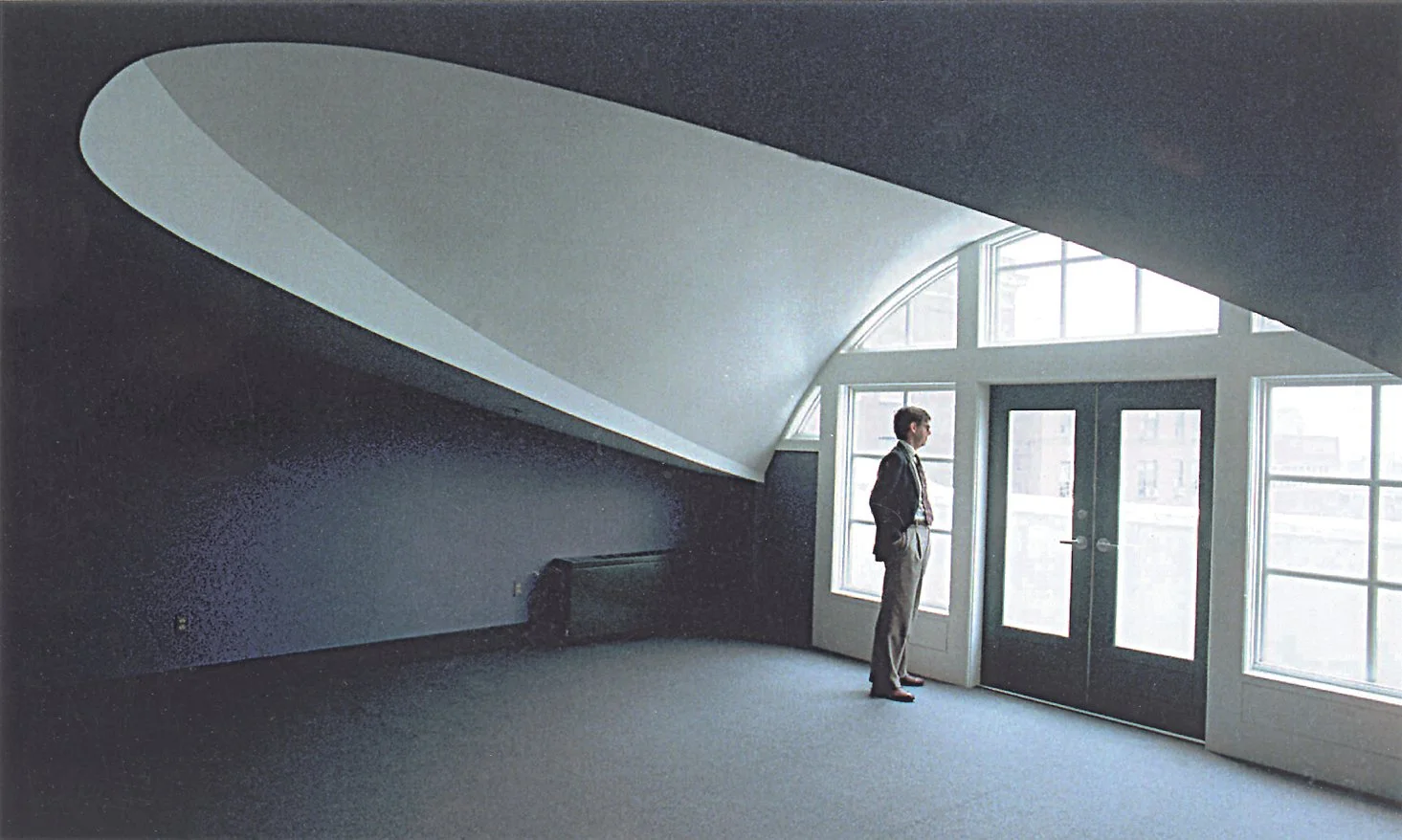When an office layout no longer works, Lisa Clemens of M&D Interiors steps in to figure out the “puzzle” of reconfiguring a workplace layout that functions well.

Baltimore County Historic Courthouse

Lisa Clemens gets excited to walk into a room and realize the space isn’t perfectly square, the corner office doesn’t function anymore, and that employees would rather have access to windows than a larger break room.
“The office world changes more often than people realize, and adjusting to those changes and making everything work with the space is a puzzle,” says Clemens, Associate and Lead Interior Designer of Murphy & Dittenhafer’s Interiors division. “I enjoy that aspect of it. Sometimes, when you put pen to paper, the space just tells you how it wants to be.”
For Anne Arundel County Government, staff are spread across four identical buildings in the Riva Road Heritage Complex. Most of the spaces in those buildings have unique interior challenges because the angles of the spaces aren’t orthogonal and some of the rooms cut off awkwardly.
Many times, Clemens gets a call from a County department when they’ve outgrown the space or found that time has changed how it’s used. Now, she says, it’s an opportunity to rethink the space to accommodate more people or design it in a way so that it functions better.

AACSP Office of the County Executive
What space planning means
It’s not paint colors and new furniture that Clemens is suggesting when helping with office and workplace space planning. Rather, it’s learning how people use the space and working with what’s already there.
In many cases, employees are reheating food and eating at their desks rather than sitting in a break room. More digital record systems mean old storage rooms are obsolete. And hybrid working conditions, which increased in the pandemic, mean workspaces can be more fluid as people work remotely – and frequently come and go from home to the office.
Like us on Facebook!
Programming is also important, she says. Clemens wants to know if an office is more of a place to land or if it’s used to meet people privately? Does each square foot have an intention or is some wiggle room intended based on the position someone has?
Those questions help her decide next steps and lead her to get creative in offering space planning to her clients. Rarely, though, is it just one idea that wins, she adds.
When she presents two or three spaceplan options to a client, it’s usually bits and pieces of each one that they love the most. That’s where Clemens works to create an integrated system that helps meet as many “wants and needs” as the space allows.

AACSP Central Services Admin Offices
Making it about the people
With Anne Arundel and Baltimore Counties, Clemens has worked quickly with multiple departments to get them back to work in spaces that meet their needs.
“It’s satisfying when you come up with things they wouldn’t have thought of — which you can do when you have a little more objectivity,” she says. “When you’re not in the office all day long it’s easier to throw out the assumptions.”
She also appreciates that office/workplace environments are changing just as quickly as the people who work in them. When she can figure out a way to make the office environment comfortable for the person who loves structure as well as the individual who can’t stand the idea of a cubicle, she considers that a win-win.
“It’s not just about looking at a space and seeing where a desk will go or where the coffee maker is stationed,” she says. “It’s about learning how people want to function and feel at work. That’s really what space planning is about, and I’m excited for the opportunity to create that for people.”
Murphy & Dittenhafer Architects is working hard and collaborating with the community on an urban planning study for South George Street in York City.
“Historic preservation has always been a hallmark of ours for our 40-year history,” says M&D President Frank Dittenhafer II. These 10 projects exemplify our passion for this work.
It’s the 40th year of Murphy & Dittenhafer Architects, so Frank Dittenhafer II, President, is taking the time to highlight some of our most influential projects over the decades.
We’re celebrating 40 years of influence in Pennsylvania and Maryland. With that, we couldn’t help but reflect on some of the most impactful projects from our history.
Harford Community College’s expanded new construction Chesapeake Welcome Center is a lesson in Architectural identity
At Murphy & Dittenhafer Architects, we feel lucky to have such awesome employees who create meaningful and impressive work. Meet the four team members we welcomed in 2024.
The ribbon-cutting ceremony at the new Department of Legislative Services (DLS) office building in Annapolis honored a truly iconic point in time for the state of Maryland.
As Murphy & Dittenhafer architects approaches 25 years in our building, we can’t help but look at how far the space has come.
Murphy & Dittenhafer Architects took on the Architecture, Interior Design, & Overall Project Management for the new Bedford Elementary School, and the outcome is impactful.
The memorial’s groundbreaking took place in June, and the dedication is set to take place on November 11, 2024, or Veterans Day.
President of Murphy & Dittenhafer Architects, Frank Dittenhafer II, spoke about the company’s contribution to York-area revitalization at the Pennsylvania Downtown Center’s Premier Revitalization Conference in June 2024. Here are the highlights.
The Pullo Center welcomed a range of student musicians in its 1,016-seat theater with full production capabilities.
“Interior designs being integral from the beginning of a project capitalize on things that make it special in the long run.”
Digital animations help Murphy & Dittenhafer Architects and clients see designs in a new light.
Frank Dittenhafer and his firm work alongside the nonprofit to fulfill the local landscape from various perspectives.
From Farquhar Park to south of the Codorus Creek, Murphy & Dittenhafer Architects help revamp York’s Penn Street.
Designs for LaVale Library, Intergenerational Center, and Beth Tfiloh Sanctuary show the value of third places.
The Annapolis Department of Legislative Services Building is under construction, reflecting the state capital’s Georgian aesthetic with modern amenities.
For the past two years, the co-founder and president of Murphy & Dittenhafer Architects has led the university’s College of Arts and Architecture Alumni Society.
The firm recently worked with St. Vincent de Paul of Baltimore to renovate an old elementary school for a Head Start pre-k program.
The market house, an 1888 Romanesque Revival brick structure designed by local Architect John A. Dempwolf, long has stood out as one of York’s premier examples of Architecture. Architect Frank Dittenhafer is passing the legacy of serving on its board to Architectural Designer Harper Brockway.
At Murphy & Dittenhafer Architects, there is a deep-rooted belief in the power of combining history and adaptive reuse with creativity.
University of Maryland Global Campus explores modernizing its administration building, which serves staffers and students enrolled in virtual classes.
The Wilkens and Essex precincts of Baltimore County are receiving solutions-based ideas for renovating or reconstructing their police stations.
The firm has earned the designation annually since 2016 in recognition of its commitment to supporting newer professionals in the field.






























To round out our 40th-year celebrations, enjoy 10 more impactful and diverse Architecture projects designed by M&D. These projects, most of which have received design awards, confirm the variety in design (from scale to usage) that we continue to be involved in today.